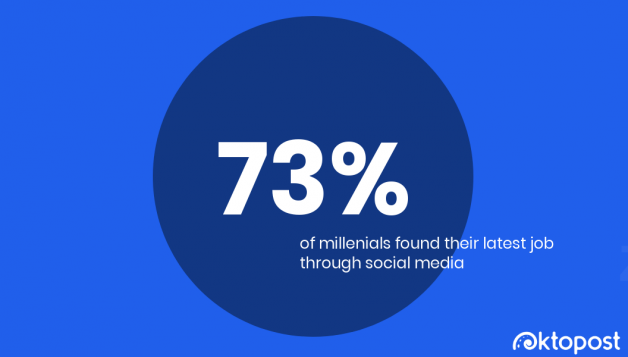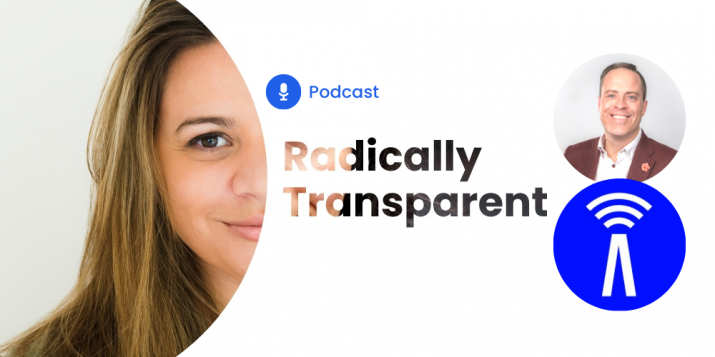
7 Tips for a successful employer branding strategy
Table of contents
Every era has a predominant mass media format, and today we are living in the era of social media. If you want as wide an audience as possible, and to get your message out in the most cost-effective way, that means your marketing should include social media.
The statistics speak for themselves. More than three billion people — nearly half the world’s population — are active on some form of social media. In the United States alone, 58% of consumers follow brands they like on social media.
The old ways of advertising popularized by passively-consumed media like magazines, radio, and television aren’t nearly as effective in this era. On social media, engagement is active and nobody has time for boring commercials or sales pitches from total strangers. But there’s a lot of noise and clutter out there among the 3 billion-plus users and multiple platforms. How do you get heard?
Many companies have turned to new strategies that leverage their most valuable asset — their workforce — to reach out directly to leads and possible new recruits. Social recruiting and employer branding are helping businesses connect, sell, and hire more effectively than ever.
Find out all you need to know about building a successful branding strategy by signing-up to one of our online webinars today!
What is social recruiting?
A comprehensive social media strategy doesn’t just have to be about hustling customers through the conversion funnel. It’s also a potential job marketplace. The most skilled and qualified candidates in the world are just a few clicks away if you know how to capture their interest.
If you need to hire the very best people to meet your goals as a company, social recruiting is worth the effort. Make no mistake, those candidates are out there. As many as 70% of job-seekers use social media to find openings. 73% of millennials (defined in this survey as anyone ages 18-34) found their last job through a social media posting.

What is an employer branding strategy (EBS)?
The common thread that can link social media recruitment and social media marketing is an Employer Branding Strategy (EBS). With an EBS, your employees act as your online brand ambassadors, in a way that comes across as organic and personal.
In other words, it’s not about forcing your employees to change the banner image behind their profile pictures to your corporate logo. Instead, employees are encouraged to share their own positive thoughts about the company, its products, and the experience of working there with friends, family, and professional contacts who follow them on social media.
This method demonstrates an authentic insight into the company’s culture. After all, candidates like to see who they will be working with and where they will be working, not just what they will be doing day in and day out.
Recommended for further reading
Which organizations need an employer branding strategy?
An EBS is a strategy that works better at scale. If you’re a small business with five employees, it probably wouldn’t make much sense to develop an EBS. On the other hand, if you have fifty employees, there’s no better time to start than right now.
If you’re a big company with 500-plus employees, you should have an EBS in place already. If you don’t, it’s time to get busy!
7 tips for creating a successful EBS
Whether you’re looking to sell more products, hire the best people, or increase positive awareness toward your brand, a strong EBS can help deliver those outcomes.
While EBS is a newer strategy still ripe for innovation, there are already some tried-and-true practices that can help you and your workers build the best EBS possible.
1. Recruit your existing employees
The world of social media isn’t a talent pool — it’s an ocean. How do you even begin narrowing your possibilities to ensure that candidates will fit in with your company?
Drawing from your existing staff, try to create a single “master persona” that personifies the entire workforce and the things they share in common. This persona is what you’re looking to recruit because it will help solidify your existing company culture.
The potential drawback is that it can lead to a very homogeneous culture, which could be detrimental in the long run. For example, a lack of diversity can negatively impact your organization not just from a recruiting perspective but also strategically. You don’t want a conference table full of “yes men” with no fresh perspectives or ideas to speak of.

Diversity is a concern across all industries at the moment, something to consider when creating or developing your company’s EBS. It’s not just about the talk; it’s about walking the walk. This needs to stem from culture right through to your creative communications and recruitment.
2. Transparency is the name of the game
One of the worst misconceptions about EBS is that it’s all about planting shills all over social media, masquerading as ordinary shoppers instead of company representatives. The last thing you want to do is put your employees in an awkward “How do you do, fellow online shoppers…” situation where it looks like they’re pretending to be something they’re not.
If you want your audience to trust you, you must be completely transparent about what you’re doing.
Likewise, when social recruiting, don’t be coy with your prospects. You’ll get a better response if you’re upfront about who you are, why you’re contacting them, and what position you’re recruiting for.
However, there is a difference between Employer Branding and Social Recruiting. The former is more like, well, branding, while the latter is more similar to lead generation. Therefore, when creating an employer brand, think of it more as a campaign designed to answer the question: “When potential employees think of working at my company, how is the company perceived?”

3. Build an employer value proposition (EVP)
Writers and filmmakers are often told to develop an “elevator pitch” for their projects. The idea is that if they get in an elevator with a big-name publisher or producer, they will have a very fleeting opportunity to pitch their product so that pitch had better be as tight and compelling as possible.
You could think of the EVP as the elevator pitch for prospective recruits. An employer value proposition is a bullet-point list of why your company is a great place to work and what employees love about it. The focus should be less on “what we do” and more on “how we do it.” Here are a few things some big companies highlight in their EVP:
- A fun work environment with social and recreational activities.
- Free, fresh food in the break room refrigerator every day.
- Freedom and opportunities to define and grow your career as you envision it.
- Ongoing investments in employees’ personal and professional growth.
- Inspiring, forward-thinking, socially responsible corporate values.
Every company’s EVP will be different. Look to your strengths, find out what employees like about working for your company, and see where you could expand on things you’re already doing to make your company even more attractive to potential hires.
4. Put your employees in the center
Your employees are the stars of the EBS show, so step back and let them take the lead once you’ve communicated your goals and expectations. The more your employees generate and post their own content, the more authentic and relatable their outreach will be.
There’s no plan or script you can follow to make employees create posts that meet the requirements of a perfect branding strategy. Trying to force it will just produce content that feels stilted and “off.”
Give your employees guidance and a clear idea of your objectives, and then let them be themselves to post content that shows genuine enthusiasm.
SAP, the German tech giant, emphasizes its corporate culture and works hard to put its employees front and center on social media (take it from a former employee ;)).

5. Put your company’s vision in the center
Think of your branding strategy as a band playing music. Your employee content creators and brand ambassadors can be out there making their own melodies, but as the company behind it all, you have to provide a steady beat that ties it all together.
Your own official corporate social media presence can help define a baseline for employee-produced content and messaging. Your branding choices and messaging should express a clear vision that your employees can refer to.

This gives them hooks and launching points they can use to integrate thematically with their own content or generate new post ideas. After all, you want your employees to create original, organic content that reflects their individual personalities—but without a clear vision to adhere to, it can be easy to lose the plot and detrimental to your brand.
6. Leverage real-time marketing
Several years ago, the high-end fashion brand Balenciaga released a $2,000 handbag that looked strangely familiar to many shoppers. The bag had the same general shape and appearance as IKEA’s polypropylene Frakta shopping bags, which are currently priced at $1.49.
IKEA jumped on the opportunity to capitalize on this viral moment by releasing a tongue-in-cheek social media ad that instructed readers on how to identify a “genuine” Frakta bag.

You can’t plan for moments like these, but you can plan on taking advantage of them when they present themselves. An EBS that’s running smoothly will be extremely well-positioned to create this kind of real-time marketing content. It’s effective and engaging.
7. Build your own voice
Some brands are fantastic at creating a corporate persona on social media.
For example, Denny’s has followers on Twitter who probably haven’t eaten there in years. However, they built a big audience because their “voice” on social media has been funny, zeitgeist-y, and a little irreverent. If their tweets convert some followers to customers, that’s a big win for Denny’s.
Highlight your company culture by posting photos, videos, and narratives about events, employee achievements, awards, and other positive stories. This can help shape your voice and project a company image that’s not a faceless organization but a collective of real people.
Conclusion
There’s no turnkey solution for an EBS. It has to be built over time in collaboration with your employees. Finding a “voice” that both represents your company and resonates with your audience may take some trial and error.
However, companies that succeed in pulling it off have an asset to branding, marketing, and recruiting that cannot be bought. You know your employees are bright, creative, awesome people — that’s why you hired them. Don’t let their talents go to waste when they could be on social media, making the best possible case for why your company is such a great place to work and shop.
Find out all you need to know about building a successful branding strategy by signing up for one of our online webinars today!




